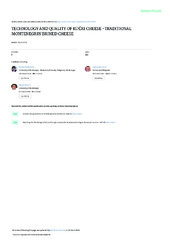Приказ основних података о документу
Technology and quality of kuČki cheese-traditional montenegrin brined cheese
| dc.creator | Jokanović, Olga | |
| dc.creator | Marković, Božidarka | |
| dc.creator | Miočinović, Jelena | |
| dc.creator | Mirecki, Slavko | |
| dc.date.accessioned | 2023-02-17T13:17:35Z | |
| dc.date.available | 2023-02-17T13:17:35Z | |
| dc.date.issued | 2021 | |
| dc.identifier.issn | 1857-8489 | |
| dc.identifier.uri | http://aspace.agrif.bg.ac.rs/handle/123456789/6285 | |
| dc.description.abstract | Kučki cheese is an inseparable part of the heritage of the Kuči region, because of the depopulation of this area, there is a danger of losing its original technology. The aim of the present study is Kučki cheese, traditional Montenegrin brined cheese. The quality of the three types of raw milk used for Kučki cheese production (cow’s, sheep’s and mixed), as well as Kučki cheese technology, the chemical, the microbiological quality and cheese yield, were investigated. The chemical quality of raw milk was analyzed by the method of infrared spectrophotometry (IR), and the somatic cells and total bacteria count by flow cytometry method. For the chemical analysis of cheese, method of Fourier transform infrared spectrophotometry (FTIR) spectrophotometry was used. The presence of following microbes was established: Listeria monocytogenes, (MEST EN ISO 11290-1:2009). Salmonella spp. (MEST EN ISO 6579:2008), and coagulase-positive Staphylococci (MEST EN ISO 4833-1:2015). The data were analysed by one way analysis of variance (ANOVA) performed using the statistical software (Software-a Statistica version 12:2012). All the milk samples had high values of the chemical quality parameters, but high numbers of somatic cells and total bacteria count indicates a lack of milking hygiene. All samples of Kučki cheese were of excellent chemical quality, but the best was Kučki cheese made from sheep’s milk (30.04% fat, 20.41% proteins, 54.71% dry matter, 54.93% fat in dry matter and 2.13% salt). The type of milk significantly influenced on differences between the fat content of the cow’s and sheep’s cheese. The same is for the fat content in the dry matter (p < 0.05). The variation of all quality parameters in cheese was highlighted. That indicated an absence of standardized technology. Microbial analysis indicated that all samples of cheeses have met the requirements of national microbiological standards. The results obtained in this study could be base for adequate data to launch initiatives for the protection of origin of Kučki cheese (PDO). © 2021, Consulting and Training Center - KEY. All rights reserved. | |
| dc.language | English | |
| dc.rights | openAccess | |
| dc.rights.uri | https://creativecommons.org/licenses/by-nc-nd/4.0/ | |
| dc.source | Journal of Hygienic Engineering and Design | |
| dc.source | Journal of Hygienic Engineering and Design | |
| dc.subject | Chemical and microbial quality | |
| dc.subject | Kučki cheese | |
| dc.subject | Raw milk | |
| dc.subject | Traditional technology | |
| dc.title | Technology and quality of kuČki cheese-traditional montenegrin brined cheese | |
| dc.type | article | en |
| dc.rights.license | BY-NC-ND | |
| dc.citation.epage | 84 | |
| dc.citation.spage | 76 | |
| dc.citation.volume | 33 | |
| dc.identifier.fulltext | http://aspace.agrif.bg.ac.rs/bitstream/id/24402/bitstream_24402.pdf | |
| dc.identifier.rcub | https://hdl.handle.net/21.15107/rcub_agrospace_6285 | |
| dc.type.version | publishedVersion |


